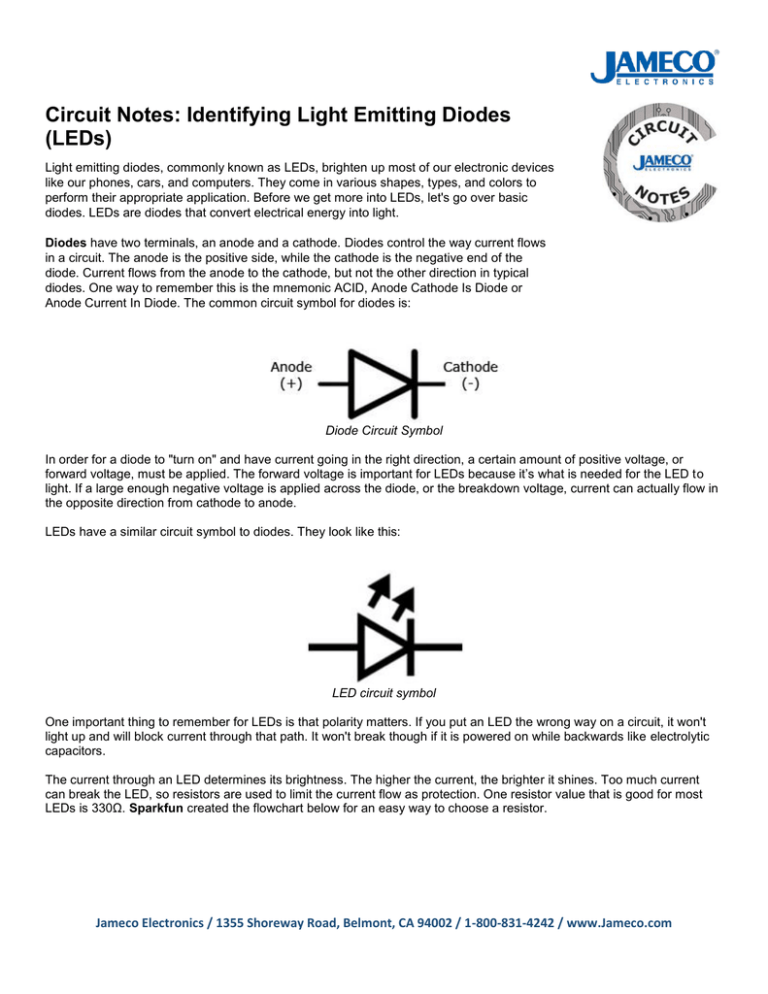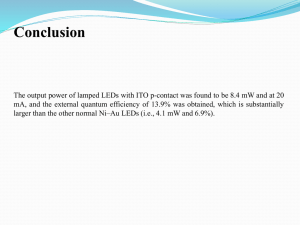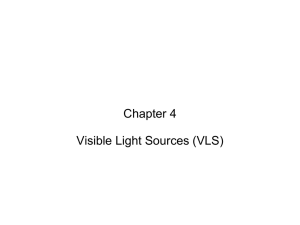Circuit Notes: Identifying Light Emitting Diodes (LEDs)
advertisement

Circuit Notes: Identifying Light Emitting Diodes (LEDs) Light emitting diodes, commonly known as LEDs, brighten up most of our electronic devices like our phones, cars, and computers. They come in various shapes, types, and colors to perform their appropriate application. Before we get more into LEDs, let's go over basic diodes. LEDs are diodes that convert electrical energy into light. Diodes have two terminals, an anode and a cathode. Diodes control the way current flows in a circuit. The anode is the positive side, while the cathode is the negative end of the diode. Current flows from the anode to the cathode, but not the other direction in typical diodes. One way to remember this is the mnemonic ACID, Anode Cathode Is Diode or Anode Current In Diode. The common circuit symbol for diodes is: Diode Circuit Symbol In order for a diode to "turn on" and have current going in the right direction, a certain amount of positive voltage, or forward voltage, must be applied. The forward voltage is important for LEDs because it’s what is needed for the LED to light. If a large enough negative voltage is applied across the diode, or the breakdown voltage, current can actually flow in the opposite direction from cathode to anode. LEDs have a similar circuit symbol to diodes. They look like this: LED circuit symbol One important thing to remember for LEDs is that polarity matters. If you put an LED the wrong way on a circuit, it won't light up and will block current through that path. It won't break though if it is powered on while backwards like electrolytic capacitors. The current through an LED determines its brightness. The higher the current, the brighter it shines. Too much current can break the LED, so resistors are used to limit the current flow as protection. One resistor value that is good for most LEDs is 330Ω. Sparkfun created the flowchart below for an easy way to choose a resistor. Jameco Electronics / 1355 Shoreway Road, Belmont, CA 94002 / 1-800-831-4242 / www.Jameco.com Flowchart for resistor values with LEDs from SparkFun The longer leads are usually the anode side in LEDs, shown here: Anode lead is the longer lead Jameco Electronics / 1355 Shoreway Road, Belmont, CA 94002 / 1-800-831-4242 / www.Jameco.com Remember the correct orientation before you clip and solder the leads or else you will end up guessing which way is correct. Different LED types are shown below. Various types of LEDs As you can see, there are diverse shapes and colors of LEDs. LEDs can be flashing, RGB, SMD, high power and IR LEDs.Flashing LEDs look similar to standard LEDs, but they include an integrated multivibrator circuit that causes the LED to flash within a defined period of time. They typically flash one color, but more sophisticated LEDs can flash multiple colors. There are bi-color and tri-color LEDs containing two or three colors, but RGB LEDs are special tri-color LEDs that can be modded to create any spectrum of color. They have four leads, one for each color of red, green, and blue and the fourth is a shared terminal of the three diodes inside known as either common cathode or common anode lead. SMD LEDs are packaged differently than through-hole versions of typical LEDs and are primarily used if you don't have enough space on your circuit. High power LEDs are classified as dissipating 1 watt or more power. They are extremely bright and used for applications like automobile headlights or high-end flashlights. They also dissipate a lot of heat, so heat sinks are normally required. Special LEDs like infrared (IR) or ultraviolet (UV) have distinctive uses. IR LEDs are used on television remotes to transfer small signals. UV LEDs help make other materials fluorescent similar to a blacklight. Alphanumeric LEDs are contained within7-segment displays. You can also find them in dot matrix format, as seen on railway departure indicators and on a calculator's starburst format. Finding the right LED depends on the application. Datasheets tell you the characteristics for the LED. Besides telling you the amount to turn on, the forward voltage, Vf, will help you determine how much voltage your circuit needs to supply, since that is the voltage drop across the LED. The forward current, If, is the amount of current the LED can handle continuously, while the peak forward current, Ifp, is the maximum current it can handle at short bursts. LED wavelength, measured in nanometers (nm), determines exactly what color the light is. Here is a small chart: Jameco Electronics / 1355 Shoreway Road, Belmont, CA 94002 / 1-800-831-4242 / www.Jameco.com Wavelength Color chart The brightness of an LED is measured in millicandela (mcd). The higher the mcd, the brighter the intensity. The ranges for brightness of LEDs are: 0-100 mcd standard, 100-1000 mcd medium, 1000+ mcd high. The viewing angle of an LED shows where the LED is the brightest. Some LEDs concentrate in a specific place, while others can be spread as widely as possible. Here is a viewing angle drawing: Viewing Angle of Illumination Chart The LED's spokes represent the viewing angle of illumination and the circular lines represent the relative distance. The blue shade shows where the sample LED shines. The LED has a narrow illumination angle of about 8° - 20° with a long illumination distance. The datasheet will lists its LED's viewing angle. Jameco Electronics / 1355 Shoreway Road, Belmont, CA 94002 / 1-800-831-4242 / www.Jameco.com





